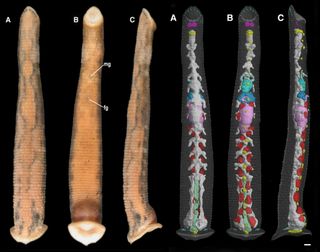Peering Inside a Leech Named for Author Amy Tan

It doesn't suck to have a new leech species named in your honor.
Acclaimed writer Amy Tan — author of numerous bestselling novels, collections of essays and children's books — will now also be known for inspiring the name of Chtonobdella tanae, a wee ground-dwelling leech from Australia. In addition, while identifying the species, the scientists also pioneered a method that allowed them to capture the soft-bodied leeches' insides in 3D.
In a study describing the new leech species, the authors credited Tan with "provoking much thought about the foibles of fieldwork" in her 2005 novel "Saving Fish From Drowning." In the book, in which a group of American tourists are kidnapped while traveling from China to Myanmar, Tan mentions ground leeches several times.
To identify the tiny leech, which measured a mere 0.4 inches (1 centimeter) long and 0.08 inches (2 millimeters) wide, the researchers turned to a noninvasive technique known as computed tomography, or CT scanning, which is frequently used to capture objects' and specimens' internal shapes in 3D, the researchers explained in the study, published online Jan. 11 in the journal Zoologica Scripta. But CT scans, commonly used to image dense, hard structures — like bone, chitin or fossilized material — don't work well on soft tissue. If this procedure was going to succeed with a leech, the scientists had to get creative. [Video: Scientists Scan an Australian Leech in 3D, Naming it for Amy Tan]
Mark Siddall, senior author of the study, credited his past work with electron microscopy for triggering the eureka moment that made it possible to CT scan a leech. Siddall, curator of invertebrate zoology at the American Museum of Natural History (AMNH) in New York, told Live Science that he recalled a procedure commonly used when readying specimens for electron microscopy. The technique, called double fixation, involves preserving a specimen by immersing it in chemical fixatives in two stages, the second of which binds a heavy metal to the specimen. Siddall suspected that this two-step process could also be used to reveal soft tissues to the CT scanner, and that suspicion proved to be correct.
Having this option for examining very small and very delicate species — or specimens too precious to damage through dissection — is, to put it mildly, a very big deal, he said.
"It opens up the opportunity of getting at all of the external and internal anatomy simultaneously, without destroying the specimen," Siddall told Live Science. "We can now leverage material that has been in museum collections for over 100 years — precious material that you don't want to damage by cutting it open. And that's huge."
Sign up for the Live Science daily newsletter now
Get the world’s most fascinating discoveries delivered straight to your inbox.
Michael Tessler, the study's lead author and a graduate student at the AMNH's Richard Gilder Graduate School, told Live Science in an email that he is looking forward to applying this process to new discoveries, too. "With this new technique, we are thinking of describing more tiny species that have, until now, been too difficult to work with," Tessler said.
Tan, meanwhile, has pronounced herself "thrilled" to lend her surname to the new species, saying in the statement that she was greatly anticipating a future trip to the leech's Australia habitat. "I hope to take leisurely walks through the jungle, accompanied by a dozen or so of my namesake feeding on my ankles," she said.
Follow Mindy Weisberger on Twitter and Google+. Follow us @livescience, Facebook & Google+. Original article on Live Science.

Mindy Weisberger is an editor at Scholastic and a former Live Science channel editor and senior writer. She has reported on general science, covering climate change, paleontology, biology, and space. Mindy studied film at Columbia University; prior to Live Science she produced, wrote and directed media for the American Museum of Natural History in New York City. Her videos about dinosaurs, astrophysics, biodiversity and evolution appear in museums and science centers worldwide, earning awards such as the CINE Golden Eagle and the Communicator Award of Excellence. Her writing has also appeared in Scientific American, The Washington Post and How It Works Magazine.
Most Popular

